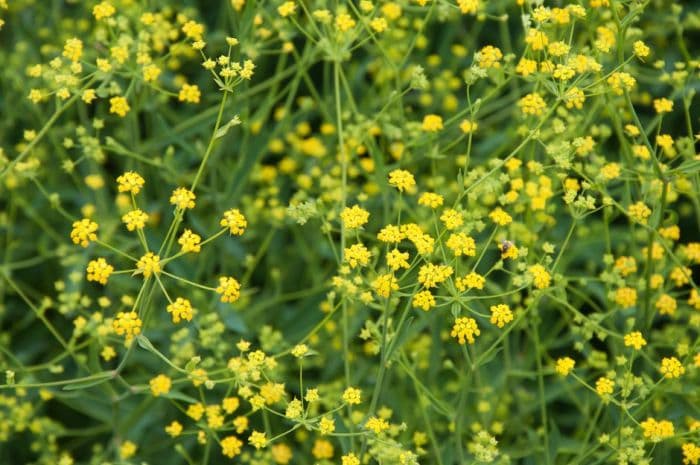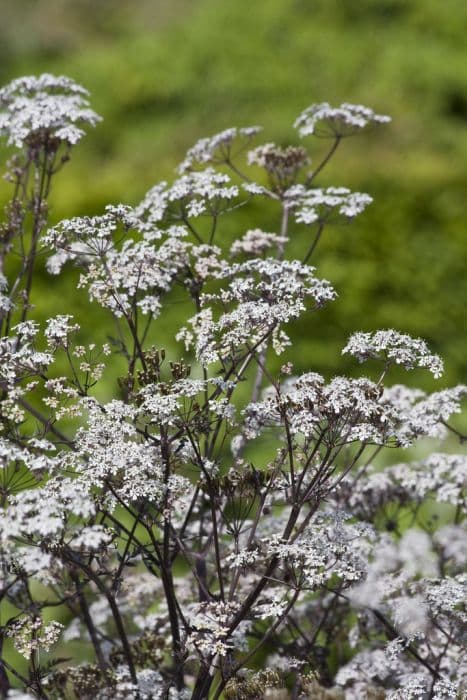Thoroughwax Bupleurum falcatum

ABOUT
The plant commonly known as "thoroughwax" or "hare's ear" has a distinctive appearance characterized by its slender, upright stems that branch out towards the top. The leaves of thoroughwax are elongated and narrow, resembling the shape of a sickle, and can sometimes have a slightly bluish or glaucous tint. They are arranged alternately along the stem, and the leaf edges often appear wavy or slightly curled. Clusters of small, yellow flowers adorn the plant and are arranged in an umbrella-like fashion at the ends of the stems, much like umbels. Each tiny flower consists of a set of five petals, five stamens, and two styles. These blossoms create a relatively flat-topped appearance, contributing to its attractive and somewhat delicate look. The combination of the light green foliage with bluish hints and the golden yellow flowers gives the plant a soft yet vibrant visual appeal. The arrangement of stems, leaves, and flowers gives it an airy and branching silhouette that can lend a feathery texture to the surroundings where it grows.
About this plant
 Names
NamesFamily
Apiaceae.
Synonyms
Sicklescale, Thoroughwax, Chinese Thoroughwax.
Common names
Bupleurum falcatum subsp. falcatum, Bupleurum falcatum var. falcatum, Bupleurum sibiricum, Bupleurum rotundifolium, Bupleurum lancifolium, Tenoria falcata, Bupleurum lancifolium var. intermedium, Bupleurum longifolium, Bupleurum longifolium subsp. rotundifolium, Bupleurum longifolium var. rotundifolium.
 Toxicity
ToxicityTo humans
Bupleurum, commonly known as thoroughwax, is not generally recognized as a toxic plant to humans. There is limited information on its toxicity because it is more commonly used in traditional herbal medicine practices for its supposed therapeutic properties. However, like with any plant or herbal supplement, individual reactions can vary. Ingesting Bupleurum in large amounts or over a prolonged period could potentially lead to adverse effects, so it is recommended to use it with caution and consult with a healthcare provider.
To pets
Thoroughwax is not widely documented to be toxic to pets. However, as pets have different metabolisms and dietary requirements than humans, caution should be exercised. If a pet ingests a large amount of Bupleurum or any unfamiliar plant, monitoring for any signs of illness or discomfort is advised, and a veterinarian should be consulted if adverse symptoms are observed.
 Characteristics
CharacteristicsLife cycle
Biennials
Foliage type
Deciduous
Color of leaves
Green
Flower color
Yellow
Height
2 feet (0.61 meters)
Spread
1 foot (0.30 meters)
Plant type
Herb
Hardiness zones
4
Native area
Asia
Benefits
 General Benefits
General Benefits- Ornamental appeal: Bupleurum falcatum, commonly known as Thorow-wax, has distinctive foliage and yellow-green flowers that can add an interesting visual contrast in gardens and landscapes.
- Low maintenance: Thorow-wax is known for being drought-tolerant and relatively easy to care for, requiring minimal watering and upkeep once established.
- Wildlife attraction: The flowers of Thorow-wax can attract beneficial insects such as bees, which are important for pollination in the garden.
- Adaptability: This plant can grow in a variety of soil types, although it prefers well-drained soils, making it versatile for different garden settings.
- Floristry use: The unique shape and structure of Thorow-wax flowers make them a popular choice for use in floral arrangements and bouquets.
- Seasonal interest: With its summer blooming period, Thorow-wax can provide visual interest during the mid-season when other plants may have finished their bloom cycle.
 Medical Properties
Medical Properties- Anti-inflammatory: Bupleurum falcatum is traditionally used for its potential anti-inflammatory properties, which may help reduce inflammation in the body.
- Liver protection: It has been used in traditional medicine to support liver health and protect against liver diseases.
- Immunomodulatory effects: Bupleurum falcatum may have effects on the immune system, potentially modulating its response.
- Antipyretic properties: The herb is used in traditional remedies for its potential to reduce fever.
- Stress and mental disorders: Bupleurum falcatum is believed to help in treating certain mental disorders and is used to alleviate stress.
- Antiviral activity: Some studies suggest that compounds in Bupleurum falcatum may possess antiviral properties.
- Hormonal balance: It is sometimes used in traditional medicine to regulate hormones and address hormonal imbalances.
- Digestive health: The plant is used to improve digestive issues such as indigestion, gas, and bloating.
 Air-purifying Qualities
Air-purifying QualitiesThis plant is not specifically known for air purifying qualities.
 Other Uses
Other Uses- Bupleurum falcatum, commonly known as thorowax, has historically been used in floral arrangements and bouquets due to its unique leaf and flower structure that provides a distinctive aesthetic.
- The stems of thorowax can be used for basket weaving; their pliability when young allows them to be woven into intricate patterns.
- In some cultures, thorowax is used in the production of natural dyes, yielding colors for fabric, especially providing shades of yellow and green.
- The plant's robustness makes it suitable for use as a natural fencing or barrier in gardens and on farms.
- Thorowax can be integrated into a butterfly or pollinator garden to attract beneficial insects due to its nectar-rich flowers.
- The dried seeds of thorowax have been used in traditional rattles or as noise-making elements in various cultural ceremonies and instruments.
- Some artisans may use dried thorowax in the creation of eco-friendly jewelry, such as necklaces or earrings.
- In companion planting, thorowax is sometimes grown alongside certain crops as it is believed to help improve soil quality over time through its root system.
- Pressed thorowax flowers are often utilized in herbarium collections for educational purposes in botany and horticulture.
- The fibrous parts of thorowax plants may be used in paper-making, contributing to a distinct texture and appearance in handcrafted paper products.
Interesting Facts
 Feng Shui
Feng ShuiBupleurum is not used in Feng Shui practice.
 Zodiac Sign Compitability
Zodiac Sign CompitabilityBupleurum is not used in astrology practice.
 Plant Symbolism
Plant Symbolism- Harmony: Bupleurum, also known as thoroughwax or hare's ear, is often used in traditional Chinese medicine to promote harmony within the body by balancing Qi, the vital life force.
- Balance: The balancing properties of Bupleurum are not only in the physical sense but also symbolize emotional and spiritual equilibrium.
- Longevity: As a medicinal plant, Bupleurum is associated with long life and good health, symbolizing wishes for a long and prosperous life.
- Protection: In some cultures, Bupleurum is believed to ward off evil spirits and bad luck, symbolizing protection and safety.
- Healing: With its use in herbal remedies, Bupleurum symbolizes healing and the restoration of health.
 Water
WaterThorough Sickle-leaf Hare's Ear watering is necessary during its active growth in spring and summer, with the soil being kept moist but not waterlogged. Water the plant approximately once a week with about 20 ounces of water, ensuring the soil is dry between watering sessions. During dormant seasons, like fall and winter, reduce watering to every other week or when the top inch of soil feels dry. Be cautious of overwatering, as this can lead to root rot.
 Light
LightSickle-leaf Hare's Ear thrives best in full sun to partial shade. It should be placed in a location where it can receive at least 6 hours of sunlight every day. Avoiding intense midday sun can help prevent scorching of the leaves, so a spot that gets morning sunlight and afternoon shade, or light dappled through tree canopies, would be ideal.
 Temperature
TemperatureSickle-leaf Hare's Ear prefers a temperature range between 50°F and 75°F. It can withstand occasional dips down to 30°F but should not be exposed to frost for prolonged periods. The ideal temperatures are generally those of temperate climates; avoid extreme heat above 85°F which can stress the plant.
 Pruning
PruningSickle-leaf Hare's Ear benefits from pruning to remove dead or yellowing leaves and to maintain its shape. Pruning should be done in the early spring, before new growth starts. Cutting back the spent stems after flowering encourages a second bloom and prevents self-seeding if not desired.
 Cleaning
CleaningAs needed
 Soil
SoilThe best soil mix for Bupleurum, also known as Thorow-wax, should be well-draining and fertile, with a pH ranging from 6.0 to 7.5. A mixture consisting of loamy soil, peat, and sand or perlite will ensure good drainage and aeration. Regular garden soil can be improved by adding organic matter like compost.
 Repotting
RepottingThorow-wax generally does not require frequent repotting; it can be repotted every 2 to 3 years or when it has outgrown its current container. Ensure that the new pot is only slightly larger than the old one to prevent overwatering.
 Humidity & Misting
Humidity & MistingThorow-wax thrives in average room humidity levels around 40-50%. It does not have high humidity requirements, making it suitable for most indoor environments without the need for additional humidity measures.
 Suitable locations
Suitable locationsIndoor
Place in bright, indirect light and avoid overwatering.
Outdoor
Sunny spot, water regularly, protect from harsh frosts.
Hardiness zone
4-8 USDA
 Life cycle
Life cycleBupleurum falcatum, commonly known as Sickle-leaved Hare's Ear, begins its life cycle as a seed, which requires a period of stratification—exposure to cold—to break dormancy and stimulate germination. Upon germination, the seedling emerges and enters a vegetative stage, developing a rosette of distinctive sickle-shaped leaves. As the plant matures, it elongates to produce a flowering stem and forms small, yellowish flowers gathered in inflorescences during the summer. After pollination, typically by insects, the flowers give way to fruit which are dry, schizocarpic capsules containing seeds ready for dispersal. The plant has a perennial habit, so after seed set, it may die back to its root system where it enters a period of dormancy before resuming growth in the next season. Throughout its life cycle, Bupleurum falcatum may also propagate clonally through its root system, creating new shoots that grow into genetically identical plants.
 Propogation
PropogationPropogation time
Spring-Early Summer
Bupleurum falcatum, commonly known as sickle-leaved hare's ear, is often propagated from seeds. The optimal time for planting seeds is in late winter or early spring, just before the last frost. The process involves sowing the seeds in well-drained soil, preferably in pots or trays, under a thin layer of soil about 1/8 inch (approximately 3 mm) deep. The seeds need light to germinate, so they should not be covered too deeply. The pots should be placed in a warm area with plenty of indirect sunlight. Germination typically occurs within 2 to 3 weeks if the conditions are right. Once the seedlings have grown sufficiently and the danger of frost has passed, they can be transplanted outdoors into their final growing positions.









